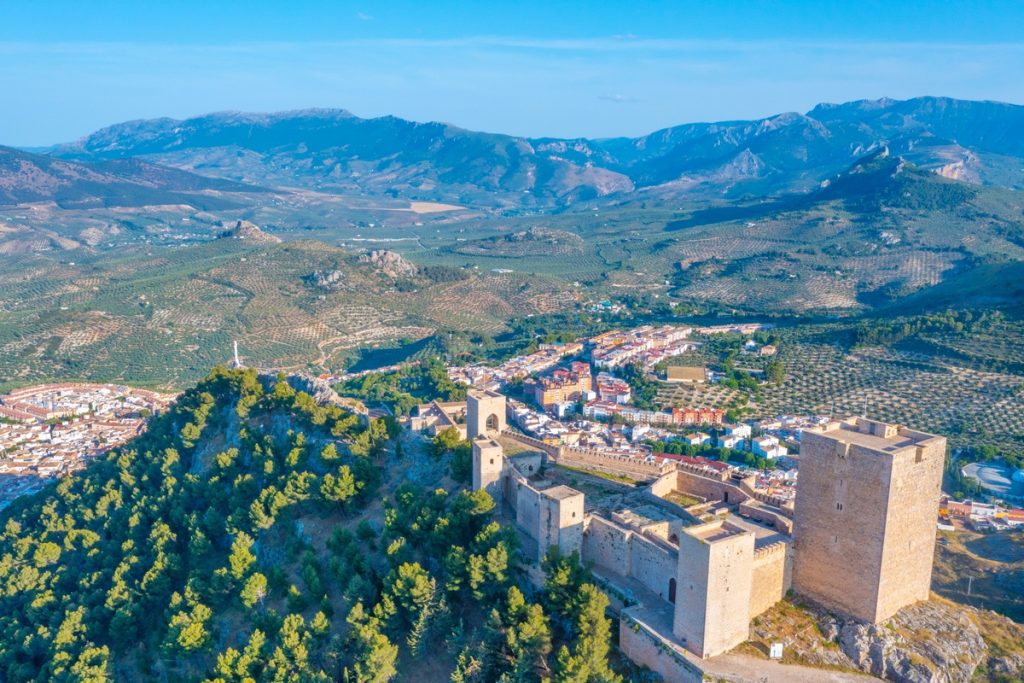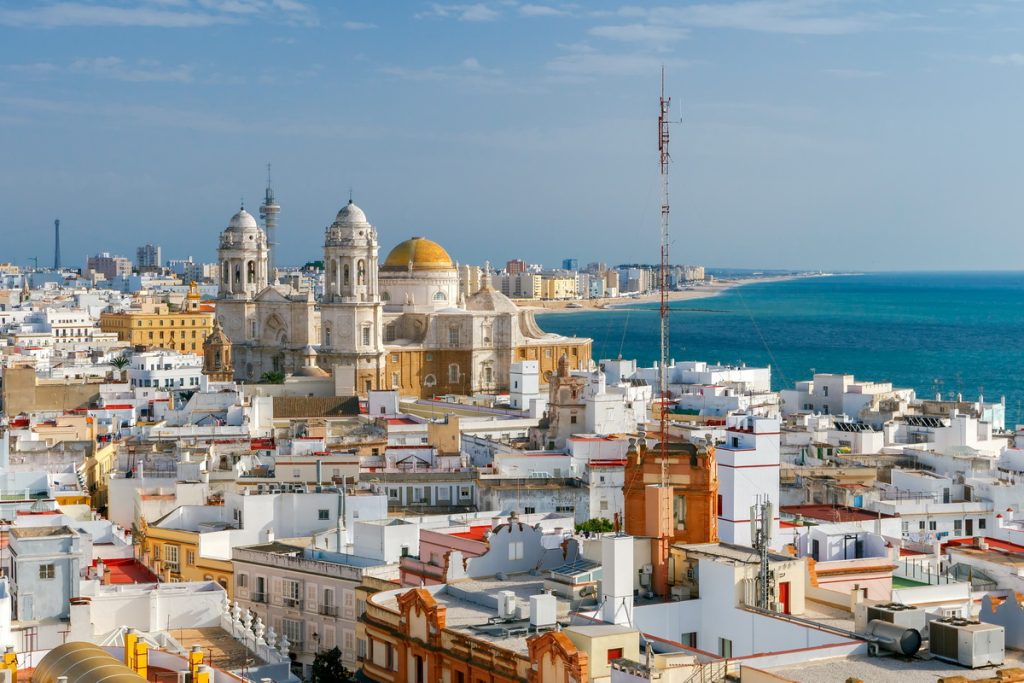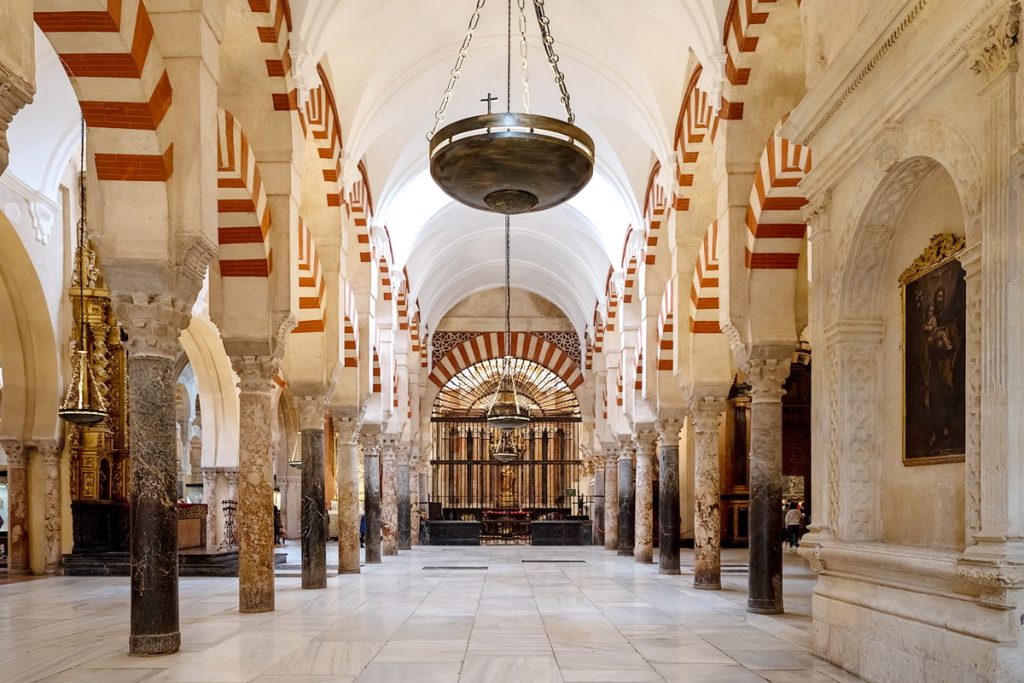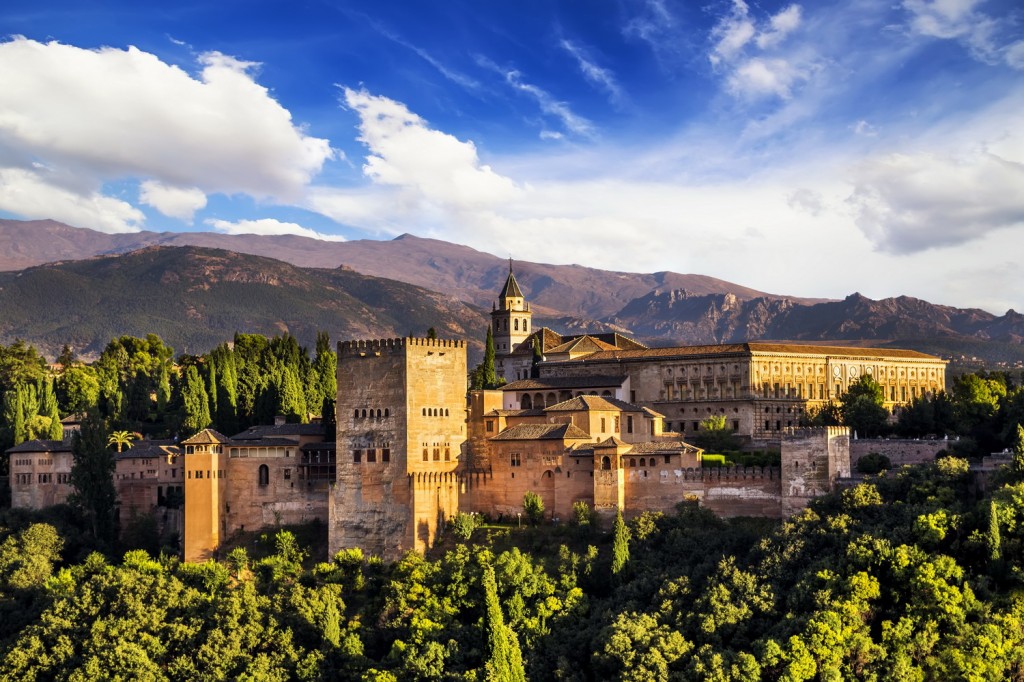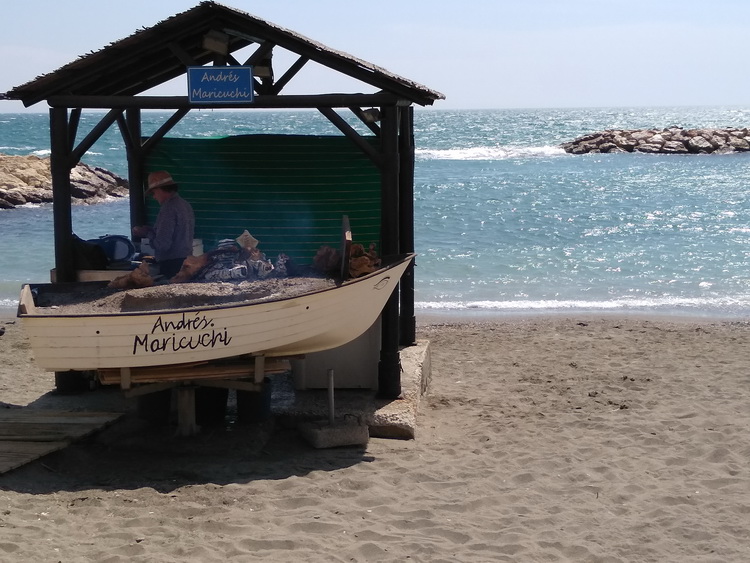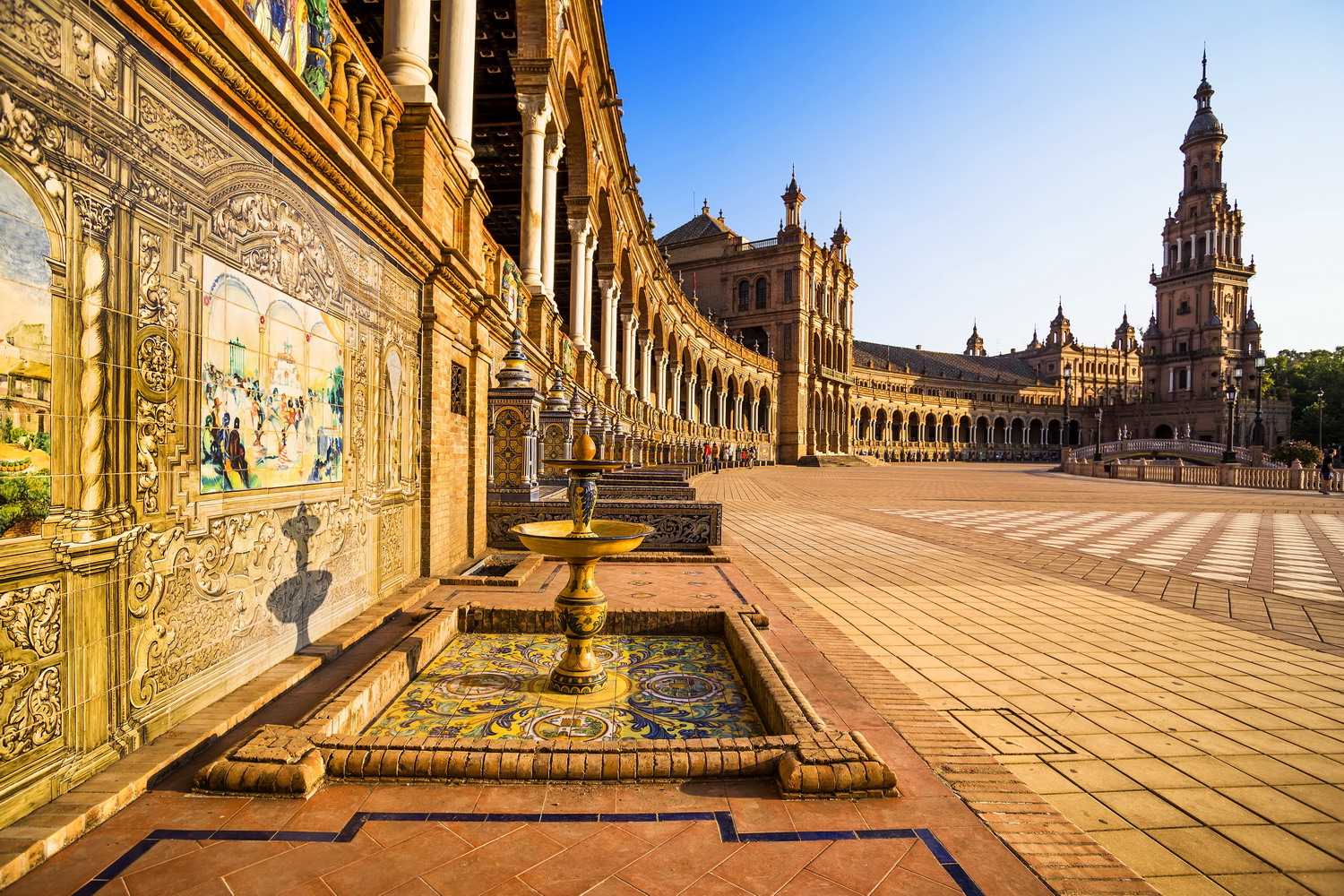
Everything you need to know for 2 or 3 days in Sevilla
There are so many things to see and do in Sevilla we usually recommend at least 3 nights in the city whether visiting on a short break or as as part of a broader tour of Andalucía . Here’s our guide covering all the Sevilla highlights…
Famous for flamenco, spotty dresses and fiestas and, of course, the eponymous oranges, Sevilla, capital of Andalucia, is a stylish and sophisticated city – brim-full of life with a truly fascinating history.
Though a full 80km from the Atlantic, the city’s once-immense riches were founded mostly on its activity as the port of the Americas in the Golden Age when Spain was a global superpower and the city enjoyed a monopoly on trade with the colonies. It was from here that Magellan set off around the world.
Founded in Roman times the city began to flourish under Muslim rule when Sevilla was second only to Còrdoba in importance and you can truly sense all this history as you explore its Old Town, Europe’s third largest, which has three UNESCO World Heritage Sites: the Cathedral and Giralda tower, the Alcázar palace, and the General Archive of the Indies.
The main festivals, Feria de Sevilla and Semana Santa (Holy week – Easter) are in the spring but the city has a special buzz at any time of the year whether you want authentic flamenco concerts or just bustling tapas bars serving Spain’s best ham and sherry direct from the barrel.
Table of Contents
Sevilla Highlights, 10 things to see and do in Sevilla City
- Alcázar Palace
- Giralda Tower
- Sevilla Cathedral
- Plaza de España
- Archivo de las Indias
- Torre de Oro
- Plaza de Toros de la Maestranza
- Barrio Santa Cruz
- Triana
- Also worth a look…
Things to See and Do in Sevilla Province – Out and about
Eat, Drink, Dance, Nap…
Practicalities – Frequently Asked Questions
Sevilla Highlights
Alcázar Palace of Sevilla
World Heritage Mudéjar Palace
One of the most impressive monuments in Seville and one of the most visited complexes in the world, the Alcazar Palace is definitely a must for anyone visiting the city. Its origins date back to the 10th century when Abd Al Ramn III (caliph of Cordoba) ordered its construction as a symbol of power and strength.
Its historical evolution has been marked by constant additions and amalgamating influences starting from the Arabic period, late Middle Ages Mudéjar right through to the Renaissance, Baroque and the XIX century. The palace halls, courtyards and gardens within its walls attest the survival of cultures and civilizations as a harmonic whole where all the elements are balanced.
It was declared a World Heritage Site by UNESCO in 1987 and nowadays cultural and educational activities, of which you may partake, are organized by the Royal Alcázar Board of Patronage and the Town Hall.
Giralda Tower
The symbol of Sevilla
Originally the minaret of the former mosque and now the belltower of Seville’s Cathedral, the Giralda was built by the Moors between 1184 and 1197. At 103mts it was the tallest building of the city for over 800 years!
It was used both for calling the faithful to prayer and as an observatory. The three golden spheres that crowned the structure disappeared due to an earthquake in the 16th Century and after several design proposals, it acquired its current appearance.
Its rigorous and austere structure links beauty with simplicity creating this masterpiece of Almohad art. A repeated pattern in sebka brick decoration, divided into three vertical sections, forms a network of diamond shaped multi-leaved arcs. At the top, a monumental sculpture -the “Giraldillo” – symbolising faith acts as a weathervane – and gives its name to the tower. It is well worth climbing to the top.
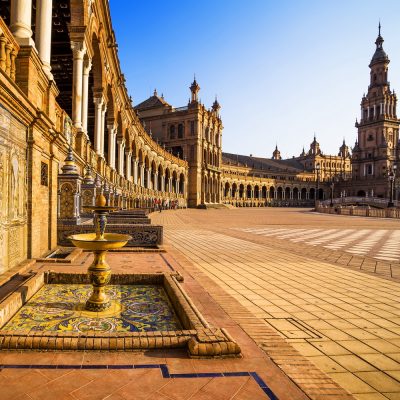
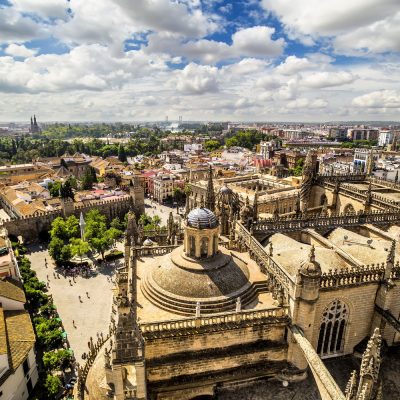
Sevilla Cathedral
A Gothic Colossus
“We shall have a church of such a kind that those who see it built will think we were mad”… said during the planning stages of Seville’s Cathedral and thus it was.
The imposing building, built upon the remains of the former mosque, is Europe’s third largest church and its largest Gothic building after St. Paul’s Cathedral in London and St. Peter’s Basilica.
The construction process was completed in just over a century (1402-1506) being one of the last Spanish Gothic cathedrals with some evident Renaissance details yet preserving the Moorish entrance court, ‘Patio de los Naranjos’, and the Giralda.
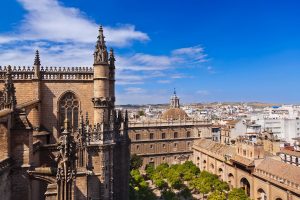
Plaza de España
An elegant oasis in the city centre
Located in the Maria Luisa Park, just south of Seville’s city centre, this imposing and spectacular architectural complex was especially designed for the Ibero-American Exposition held in Seville in 1929. Its creator, the local architect Anibal Gonzalez, mixed typical elements of the city with Art Deco, Mudejar, and Renaissance Revival influences capturing not only the beauty of Seville and Andalusia but the essence of the entire country.
The semi-circular structure is dominated by two towers at each end which frame the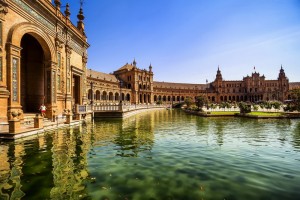
Don’t miss the opportunity to discover this jewel and if you have enough time take a leisurely walk through the rest of the Maria Luis Park, one of the most beautiful in Europe.
Archivo de las Indias
The memory of the New World
Next to the Cathedral, the Indies archive is one of Seville’s UNESCO World Heritage Site and one its most important buildings as it houses 80 million pages of documents and maps providing the most complete and documented historical view of the Spanish administration of the New World.
It was originally built to be the Mercaderes Market in 1572 by the famous architect Juan de Herrera and represented the centre of all the financial and commercial transactions that provided Seville with its huge wealth during this period.
In 1785 it was modified to house the Archivo General de Indias and nowadays is open to the public so it is worth visiting it not only to enjoy its magnificent central patio, galleries and rooms but to discover “the memory of the New World”.
Torre de Oro
The Golden Tower
The Golden Tower was one of the last buildings constructed in Seville by the Muslims around 1220 and possibly the most photographed monument of the city. Strategically located near the Guadalquivir river bank, it was designed as a defensive tower to protect the port and to regulate the access to the river by a thick chain which linked it to another tower on the opposite bank.
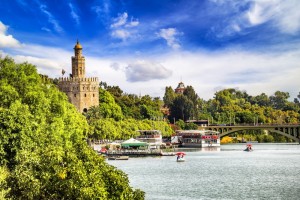
After the reconquest of Seville, it was used for many purposes and now houses the Maritime Museum’s collection where you will learn more about the city’s naval history and its important connection with the New World.
Plaza de Toros de la Maestranza
The Bull Ring
Built in 1761 and immortalized in Bizet’s Carmen, the Plaza de Toros de la Maestranza in Seville is one of the most famous bullrings in Spain and one of the oldest one in the World.
With an impressive Baroque façade and the slightly oval shape of the ring, its arena accommodates 14000 where the perfect acoustics allows to hear everything wherever you are sitting. Throughout all these years, thousands of bullfighters have been carried out on the audience’s shoulders through its main entrance – Puerta del Principe – after an outstanding performance.
It has a museum with paintings, costumes and other artifacts. Even if you dislike bullfighting, it is worth a visit only for its architecture.
Barrio Santa Cruz
The Sant Cruz neighbourhood
Formerly the Jewish quarter, Santa Cruz is the most picturesque and charming part of medieval Seville. It was taken over by the Christians at the end of the 14th Century. Therefore, some of its churches were originally synagogues.
As you leave the Alcazar through the Patio de Banderas, the amazing view of the Cathedral will introduce you to the hidden treasures of its narrow alleys, gardens and squares. Every detail will take you through history here.
Wander round the Calle de las Juderías and the Callejón del Agua (Water alley) to admire the ancient mansions with their leafy patios decorated with spectacular tiles and local potteries. Get into the Plaza Alfaro and the delightful Plaza Santa Cruz (where Murillo, one of Spain’s most famous painters was born) or just sit outside a bar and relax with a refreshing drink.
Triana
Sevilla’s left-bank neighbourhood
Located on the left bank of the Guadalquivir River, Triana district is connected to the city by the iconic bridge of Isabel II (also known as Puente de Triana) from where you can enjoy a splendid view of its monuments along the river. It was named after the emperor Trajano and its rich past has turned it into a vibrant district with its own strong identity.
The neighbourhood has been home to the world-renowned tile workshops and potteries (Santa Ana is the most famous one). In fact, Seville and Triana itself can be considered as an open-air museum proudly showing their jewels in their churches, private mansions and bars.
Triana’s history has always been related to the gypsy culture. Famous bullfighters and flamenco artists were born here making Triana the spiritual heart of flamenco and one of the most colourful Seville’s quarters. Don’t miss it!
Also worth a look…
Some less well known things to see and do in Sevilla
Casa de Pilatos
Modelled after the Roman Domus of Pontius Pilate the tour of upstairs is good, in Spanish and English, but the most memorable part is the downstairs patio with detailed audio guide, if that’s your thing.
Palacio de las Dueñas
Spectacular gardens and terrace, fascinating family history and lots of flamenco memorabilia.
Basílica de la Macarena
Built in 1949 this is a modern church, but the Virgen de la Macarena is well worth a view, particularly from behind.
Church of San Luis de los Francesas
Also in Macarena, a masterpiece of the baroque style. The painted walls and ceiling are particularly stunning.
Hospital de los Venerables Sacerdotes
Santa Cruz, many baroque splendours with frescoes by Juan de Valdés Leal.
Iglesia de Santa María la Blanca
Santa Cruz, built originally in the 13th century as a synagogue.
Museo de Belles Artes
lovely building, once a convent church with lots of religious art, but some good stuff from Murillo, Leal.
Museo Arqueologico
includes many exhibits discovered in Italíca (see highlights).
Museo del Baile Flamenco
worth a visit if you are a flamenco fan. See our seperate section on Flamenco in Sevilla
Things to See and Do in Sevilla Province
Italica
Roman treasures a bus ride from the city
Just 40 minutes bus ride from the city centre Italica, founded in 206 BC was the first Roman city of the peninsula and home of the emperors Trajan and Hadrian.
It boasts one of the most well-preserved Roman amphitheatres in the world, once holding up to 25,000 spectators as well as extensive ruins of the city, not quite Pompeii but you’ll find marvellous mosaics, ancient streets, and the foundations of Roman houses – among which the childhood home of the Emperor and builder of walls, Hadrian.
Carmona
Sevilla in miniature
Known as the mini-Sevilla, Carmona has its own Alcazar, now a Parador, and two magnificent monumental gates, the best of which, la Puerta de Sevilla, has splendid Moorish archways sitting atop Roman foundations. There’s even a copy of the Giralda, La Giraldilla, just outside the town walls.
Thought to be older than Sevilla, neolithic remains have been found nearby and there is a fine Roman necropolis just a short distance from the city. In the city museum you can see some fine pottery left behind by the Tartesos but everywhere you look you’ll find the traces left by passing empires.
The old town occupies a strategic position and offers magnificent views over the surrounding vega (fertile river basin). It is nice and compact and easy to get around on foot and there are plenty of authentic tapas bars and restaurants and pleasant squares and terraces to relax and enjoy the local ‘ambiente’.
Osuna
Historic setting for Game of Thrones
Founded by Marco Antonio and scene of the last battle won by Julius Cesar, Osuna has a history going back three thousand years. In the 15th century the town was the seat of the Dukes of Osuna who rose to great power under Phillip II owning vast tracts of land with titles including Governor of Naples.
The town has an interesting medieval University dating from 1548 and still in use but visitable as well as a Colegiata built at the same time and its high street, Calle San Pedro, is exceptionally well kept and listed as a monument since the 1960’s, with many palaces and mansions Gothic, Renaissance, and Baroque styles.
Nowadays the town is famous for being the scene of much of the 5th series of Game of Thrones.
Sierra Morena
Sevilla’s wild mountain range
Stretching across several provinces the Sierra Morena is a vast mountain range with oak and cork forests interspersed with rocky outcrops and dramatic gorges providing habitat to various wildlife, including the Iberian lynx, griffon and Egyptian vulture, imperial eagle, and wild boar.
Eat, Drink, Dance, Nap
Flamenco – one of the essential things to see and do in Sevilla
There is a wide variety of tablaos (dance floors where flamenco is performed) in Sevilla, some with twice or even thrice nightly shows of usually about an hour long. The performers change regularly. There’s much debate over which is the most authentic flamenco experience but in some part it’s tourism that keeps this fascinating art form alive – so we say ‘go with the flow’!
You’ll get our own recommendations as part of your info pack and we’ve been very fortunate to enlist the services of Sam Beal – coach, blogger, hispanophile and Flamenco fanatic who’s given us some insider tips for getting to the heart of the Sevilla flamenco scene…
Eating and drinking in Sevilla
Without doubt one of our favourite cities for eating out! Sevilla is great for bar-hopping and tapas or more formal dining out – most places offer both options. There are some tourist traps particularly close to the Cathedral and Barrio Santa Cruz so take care – we particularly like the area at the back of the bullring, whilst Triana, over the river, is the trendy up-and-coming area.
Local specialities include Pringá (stewed shredded pork, chorizo, and morcilla in a small bun), Rabo de Toro (oxtail) and, of course Jamón Serrano – of the latter why not splash out and order the bellota (but be careful if they offer you a mixed plate of ham and cheese, it can be a rip off).
You’ll get our own restaurant recommendations as part of your information pack and Vamoos app but do ask your hotel for recommendations as things are always changing and new things popping up.
Taking it easy in Sevilla
Our top tip for getting the most out of your visit
Sevilla’s such an exciting city with so much to see and do whilst at the same time having one of the hottest climates in Europe – which can easily be an exhausting combination!
We recommend you ‘go native’ and take time and head indoors for a decent rest in the hottest hours of the day.
This is especially true in the summer but will help you adjust to the local rhythms at any time of the year. It’s easy to burn out and be heading to bed before the locals have come out to play of an evening, and you really don’t want to miss the genuine buzz of a Sevillian tapas bar!
Frequently asked questions about things to see and do in Sevilla
How to get to Sevilla
By air from the UK
- From Gatwick with Easyjet, Vueling or BA
- From Stansted with Ryanair
- From Luton with Ryanair
- From Manchester with Ryanair
- From Edinburgh with Ryanair
- or fly to Málaga or Jerez then take a hire car or train…
Sevilla has high-speed train links with Córdoba, Madrid and (indirectly) with Málaga.
When to go to Sevilla?
A visit to Sevilla is best enjoyed in the Spring or the Autumn. From mid-March through to early July then from September through to mid-November.
At the height of summer temperatures can often reach the low 40s Centigrade – so best avoided unless you really like the heat (though with air-conditioning and a siesta it can be made possible, and the city is at its quietest).
The winter months can be quite cool but the average temperature ranges between lows of 5ºC and highs of 15ºC – so a good time to see the city without the crowds. Take care if combining with Granada however as that city is at a much higher altitude and can see some snow!
How long to stay in Sevilla?
Normally we recommend three nights when taken as part of an Andalucía touring holiday though you could possibly see the top sights in two.
If you can spare more time there’s no end of things to see in the city and you could also take an excursion to nearby Carmona and Osuna, or visit the Roman ruins at Italica which is just a bus ride away.
What to eat in Sevilla?
What to buy in Sevilla?
Wherever you go in Sevilla you’ll find plenty of souvenir shops selling the ‘typical Spanish’, ‘Olé, Olé’ bric-a-brac.
For a classy, easy-to-pack and authentic memoir (which you might find very useful during your stay) look out for artisan-made folding fans or ‘abanicos’. There are plenty of shops in the Vera Cruz neighbourhood offering some very stylish models or head to Padilla Crespo a la Ancha, where you might also pick up a nice ‘Cordobés hat…
Another uniquely-Sevillian, portable take-away is an azulejo tile from the Triana neighbourhood on the west bank. Head for Calle Antillano Campos where you’ll find a good choice orf ceramics shops with a centuries’ old tradition.


